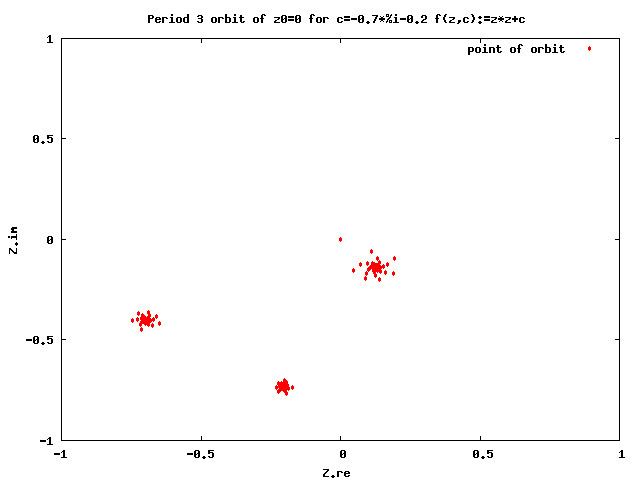 | ||
A complex quadratic polynomial is a quadratic polynomial whose coefficients and variable are complex numbers.
Contents
Forms
When the quadratic polynomial has only one variable (univariate), one can distinguish its 4 main forms:
The monic and centered form has the following properties:
Between forms
Since
When one wants change from
When one wants change from
and the transformation between the variables in
With doubling map
There is semi-conjugacy between the dyadic transformation (the doubling map) and the quadratic polynomial case of c = –2.
Map
The monic and centered form, sometimes called the Douady-Hubbard family of quadratic polynomials, is typically used with variable
When it is used as an evolution function of the discrete nonlinear dynamical system
it is named the quadratic map:
The Mandelbrot set is the set of values of the parameter c for which the initial condition z0 = 0 does not cause the iterates to diverge to infinity.
Notation
Here
so
Because of the possible confusion with exponentiation, some authors write
Critical point
A critical point of
Since
implies
we see that the only (finite) critical point of
Critical value
A critical value
Since
we have
So the parameter
Critical orbit
The forward orbit of a critical point is called a critical orbit. Critical orbits are very important because every attracting periodic orbit attracts a critical point, so studying the critical orbits helps us understand the dynamics in the Fatou set.
This orbit falls into an attracting periodic cycle if one exists.
Critical sector
The critical sector is a sector of the dynamical plane containing the critical point.
Critical polynomial
so
These polynomials are used for:
Critical curves
Diagrams of critical polynomials are called critical curves.
These curves create the skeleton (the dark lines) of a bifurcation diagram.
Planes
One can use the Julia-Mandelbrot 4-dimensional space for a global analysis of this dynamical system.
In this space there are 2 basic types of 2-D planes:
There is also another plane used to analyze such dynamical systems w-plane:
Parameter plane
The phase space of a quadratic map is called its parameter plane. Here:
There is no dynamics here. It is only a set of parameter values. There are no orbits on the parameter plane.
The parameter plane consists of:
There are many different subtypes of the parameter plane.
Dynamical plane
On the dynamical plane one can find:
The dynamical plane consists of:
Here,
The two-dimensional dynamical plane can be treated as a Poincaré cross-section of three-dimensional space of continuous dynamical system.
Dynamical z-planes can be divided in two groups :
Derivative with respect to c
On the parameter plane:
The first derivative of
This derivative can be found by iteration starting with
and then replacing at every consecutive step
This can easily be verified by using the chain rule for the derivative.
This derivative is used in the distance estimation method for drawing a Mandelbrot set.
Derivative with respect to z
On the dynamical plane:
At a fixed point
At a periodic point z0 of period p the first derivative of a function
is often represented by
At a nonperiodic point, the derivative, denoted by
and then using
This derivative is used for computing the external distance to the Julia set.
Schwarzian derivative
The Schwarzian derivative (SD for short) of f is:
